16. Abandonment: When to Plug & Seal Test Holes & Dewatering Wells
Chapter Description
This chapter outlines when the Wells Regulation requires that a test hole or dewatering well be abandoned by the well owner or the person constructing the well. It also provides the steps that a well owner may take to seek written consent from the Director to allow for the continued use of the well. Chapter 17: Abandonment: How to Plug & Seal Test Holes & Dewatering Wells outlines the sequential approach and materials used to plug and seal a well.
Regulatory Requirements - Abandonment
Relevant Sections - The Wells Regulation
Abandonment - Section 21 (when to abandon a well) Subsetion 21(11)
The Requirements - Plainly Stated
The Wells Regulation requires a well to be abandoned based on the following:
When to Abandon a Test Hole or Dewatering Well:
Person Constructing the Well
If construction is completely stopped (i.e., discontinued) before completion of the new test hole or dewatering well’s structural stage and no other person completes the new well to its structural stage, the person constructing the well must immediately abandon the well.
Well Purchaser
The well purchaser of a new test hole or dewatering well that is dry must immediately abandon the well unless the owner of the land on which the well is situated agrees in writing to maintain the well for future use as a well.
Well Owner
The well owner must immediately abandon a test hole or dewatering well if it:
- is not being used or maintained for future use as a well,
- contains natural gas or other gas (unless measures are taken by the well owner to manage the gas in a way that prevents any potential hazard),
- permits any movement of natural gas, contaminants or other materials between subsurface formations (aquifers), or between a subsurface formation and the ground surface, and the movement may impair the quality of any waters (unless measures are taken by the well owner that prevent the movement at all times), or
- is constructed in contravention of any provision of the Wells Regulation dealing with the location of wells, the methods and materials used in the construction of wells or the standards of well construction, and the steps taken to immediately rectify the situation have failed.
The well owner does not have to immediately abandon a test hole or dewatering well if it:
- produces mineralized water, or
- produces water that is not potable.
Reminder: In most cases, the well purchaser or well owner will retain a licensed well contractor and well technician to abandon the well (see Chapter 17: Abandonment: How to Plug & Seal Wells).
Director’s Written Consent not to Abandon a Well
The well owner is not required to abandon a test hole or dewatering well if the well owner has sought and obtained the written consent of the Director to allow for the continued use of the well for the following situations:
- a well contains natural gas or other gas and the well owner has not taken measures to manage the gas to prevent any potential hazard,
- a well permits any movement of natural gas, contaminants or other materials between subsurface formations (e.g., aquifers), or between a subsurface formation and the ground surface, the movement may impair the quality of any waters and the well owner has not taken measures to prevent the movement, or
- the steps taken by the well owner have failed to rectify a situation where a well has been constructed in contravention of any provision of the Wells Regulation dealing with the location of wells, the methods and the materials used in the construction of wells, or standards of well construction.
Key Concepts
What Is an Improperly Abandoned Well?
An improperly abandoned test hole or dewatering well is one that has not been plugged and sealed and that is any of the following:
- No longer used or maintained for use as a well
- In such disrepair that its continued use for obtaining groundwater or information on groundwater conditions is impractical
- A well that has been left uncompleted
Figure 16-1: Improperly Abandoned Test Hole
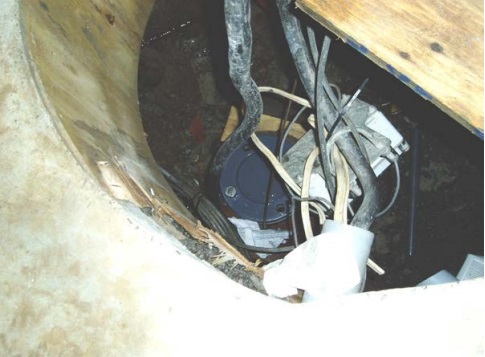
Figure 16-1 shows an improperly abandoned drilled test hole inside a well pit. A blue sanitary well seal, with missing bolts, is affixed to the top of the well in the centre of the photograph. The missing bolts create two known openings in the seal. Hazardous electrical cables pose a danger. Waterlines and cables for monitoring devices are also present. Water and debris such as an empty petroleum product container are visible. Water in the well pit rises above the well cap when a sump pump (not shown in the photograph) is not operational and can enter the well. In this case, there is a hydraulic connection between the test hole and a municipal well posing a risk to the water quality of the municipal water supply.
How Many Wells and Abandoned Wells are There in Ontario?
From the late 1940s, well contractors have been required to report drilled and bored well construction operations to the well owner and the Ontario Government. In the late 1980s, all persons constructing dug wells were required to complete well records. Well records are required to be submitted to the Ministry to document many well construction, alteration or abandonment of wells in Ontario. Over 700,000 well records have been submitted to the Ministry over the years with approximately 15,000 new well records received each year. The number of test holes and dewatering wells installed in Ontario each year exceed the number of water supply wells that are installed.
At this time no one knows exactly how many wells or abandoned wells exist in the Province of Ontario due to the evolving reporting requirements for wells. There are also some exemptions to the reporting requirements for test holes and dewatering wells that meet the shallow works exemption criteria or that are abandoned within 30 days of the date on which the new or altered well’s structural stage is complete.
If a well has been reported to the Ministry, a copy of the record can be requested from the Ministry to assist in the plugging and sealing of a well. The well record search request forms are available on the Government of Ontario Central Forms Repository (also by typing “wells” in the search bar) or by contacting the Ministry’s Well Help Desk at
It is important that land owners understand their responsibilities under the Wells Regulation. It is important for environmental protection and health and safety reasons that land owners take the time to investigate and identify improperly abandoned wells that may exist on their properties. The well construction industry and environmental consultants should assist well owners in identifying improperly abandoned wells when working on a property and inform them of their responsibilities under the Wells Regulation.
What Problems Do Improperly Abandoned Wells Present?
Improperly abandoned wells may pose many problems including any or all of the following:
- They can act as pathways for the movement of near-surface contaminants into aquifers (groundwater supplies) and compromise the monitoring results of nearby test holes (Figure 16-2 to Figure 16-5).
- They can pose a threat to children, adults or animals who may fall into large diameter openings and become trapped or injured (see Figure 16-2).
- They can interconnect fresh groundwater with salty, mineralized or contaminated groundwater zones and allow the mineralized or contaminated water to enter into fresh water zones (See Figure 16-6).
- They can present a hazard to equipment and vehicles.
- They can flow uncontrollably at the surface resulting in groundwater waste, nuisance or flooding problems (see Figure 16-3).
Figure 16-2: Improperly Abandoned Large Diameter Test Hole

Figure 16-2 shows a large diameter, improperly abandoned dug test hole with a broken well cover. The abandoned test hole is located on a closed waste disposal site. It was originally used for sampling and monitoring. Someone has placed concrete blocks into the access lid of the well cover. The blocks can be easily removed or fall from the access lid into the well. The well cover presents a safety hazard for persons working or doing other activities at the well site. Also, surface water and other foreign materials can migrate through the well cover openings into the well and can impair the groundwater.
Figure 16-3: Improperly Abandoned Earth Energy Test Hole

Figure 16-3 shows an improperly abandoned test hole used to determine the feasibility of a vertical hole closed loop earth energy system. Two black U-loop pipes have been installed into the test hole through a sanitary well seal. A sanitary well seal was used to seal the tubes to the top of the well casing. The sanitary well seal has not been placed properly on the top of the well creating an opening in the sanitary well seal which allows for surface water, contaminants and other foreign materials to enter the test hole and possibly impair the groundwater.
Figure 16-4: Improperly Abandoned Nested Multi-level Test Hole with Seals
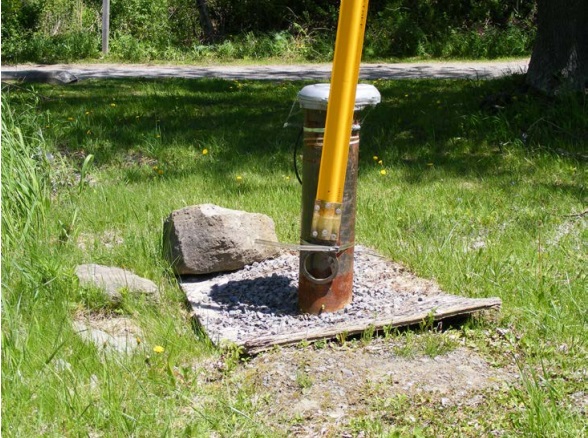
Figure 16-4 shows an improperly abandoned test hole originally used to monitor water levels and water quality from discrete zones in a bedrock aquifer. A large open hole exists around the well casing (see Figure 16-5). The hole is covered by a loose piece of plywood that surrounds the outer casing. The hole acts as a physical hazard and allows surface water and other foreign materials to pond adjacent to the well casing. There is a potential for surface water and other foreign materials to migrate down the side of the outer casing and impair the groundwater used by a municipal well located nearby.
Figure 16-5: Improperly Abandoned Nested Multi-level Test Hole with Seals
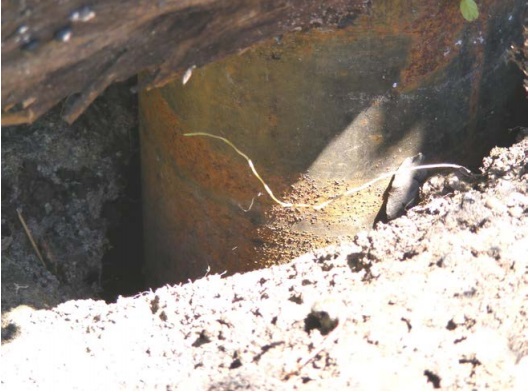
Figure 16-5 shows a closer view of the open area below the plywood of the test hole shown in Figure 16-4.
Figure 16-6: Improperly Abandoned Nested Multi-level Test Hole with Seals
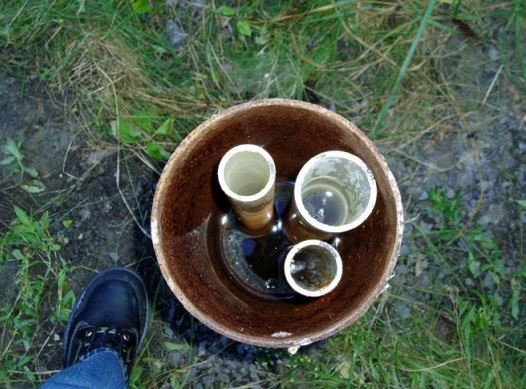
Figure 16-6 shows the interior of the of the same test hole shown in Figure 16-4. There are three white PVC plastic casings surrounded by groundwater within the permanent steel outer casing. The plastic casings extend to well screens located at different intervals in the test hole. Sealant has not been properly placed between the well screens or at the top of the well. Thus, groundwater has moved from the aquifers to near the top of the well. Groundwater and potential contaminants from the different zones in the bedrock are being allowed to intermingle which may impair waters.
Figure 16-7: Abandoned Relief Well
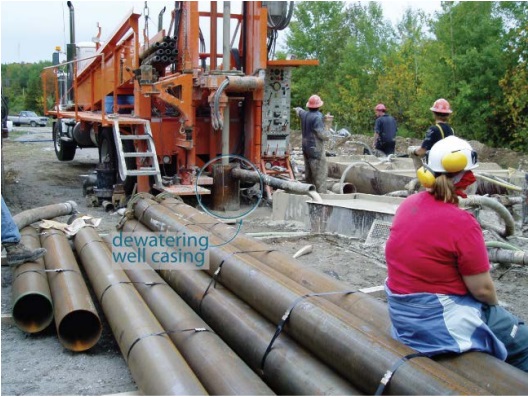
Figure 16-7 shows a relief (dewatering) well constructed in an attempt to lower the groundwater level to stop a nearby uncontrolled flowing well. The casing of the dewatering well is located at the rear of the drilling rig. During drilling, the relief well started to flow uncontrollably. The driller and consultant attempted to pump drilling mud into the hole to stop the flow, but this failed. Mud and groundwater can be seen discharging from the well into a nearby tub.
Merely capping or covering the top of a well is not enough to prevent the well from becoming a problem as shown in Figures 16-1 to 16-5.
To help protect the health and safety of humans and protect the environment, improperly abandoned wells need to be properly plugged and sealed as described in Chapter 17: Abandonement: How to Plug & Seal Test Holes & Dewatering Wells.
How to Locate Improperly Abandoned Wells on a Property
A person may wish to inspect his or her property for signs of an existing unused well. Some indicators of wells include any of the following:
- Small diameter PVC pipe sticking out of the ground (Figure 16-8)
- Protective cover sticking out of the ground (Figure 16-9)
- Flush-mounted cover plate on the ground (Figure 16-11)
- Depression in the ground
- An above ground structure (e.g., pump house) (Figure 16-12)
- Flowing water, or constant wet area on the ground surface
Figure 16-8: Test Hole
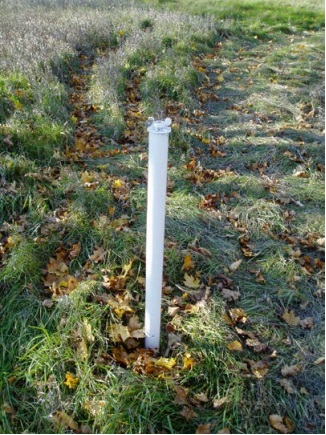
Figure 16-8 shows a white plastic well casing extending out of the ground with a standard J plug well cap.
Figure 16-9: test Holes with Protective Well Covers

Figure 16-9 shows two monitoring wells covered with above ground blue protective well covers.
Figure 16-10: Hidden Test Hole

In many cases, brush or debris can hide a well. As shown in Figure 16-10, tall grass and brush hide an open and deteriorated brown protective well cover (centre of the photograph).
Figure 16-11: Flush-mounted Well Pits (Vaults)

Figure 16-11 shows the tops of three blue flushmounted well covers. Test holes are located below the well covers in flush-mounted well pits (vaults).
Figure 16-12: Dewatering Well in Above Ground Structure
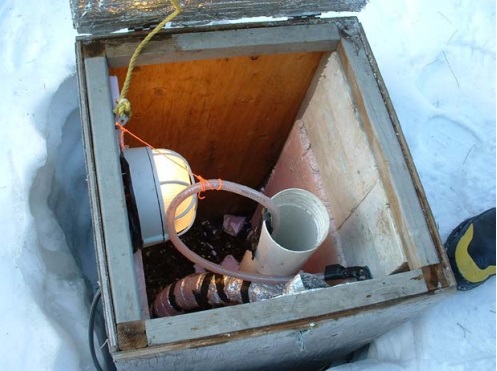
Figure 16-12 shows a dewatering well located in a small above ground structure.
If there is a possibility that a well is buried below the ground surface, the following sources of information may assist in locating the well:
- Former property owners or neighbours
- Well record reports
- Property surveys
- Old photographs
- Old construction site survey plans
- Phase II Environmental Site Assessments
Two methods of locating a buried well include:
- a metal detector for wells with steel casing and
- a plumber’s video camera equipment and an above ground camera equipment receiver for wells where a horizontal waterline extends from the buried well into a building.
Figure 16-13: Buried Well And Water Lines

Figure 16-13 shows a buried well and waterlines exposed after excavating from the ground surface. Buried wells are difficult to locate and detection devices may be needed. In this case there is no well cap to stop surface water or other foreign materials from entering the well.
Who is Responsible for Plugging and Sealing Wells
Well owners, well purchasers or persons constructing wells must abandon (plug and seal) a test hole or dewatering well using the nine sequential step approach (see Chapter 17: Abandonment: How to Plug and Seal Test Holes & Dewatering Wells) for unfinished wells, certain well construction and maintenance deficiencies, water quantity problems and water quality problems. These requirements for abandonment are described in the following sections.
Reminder: Shallow works are usually exempt from the nine sequential step procedure and where exempt have their own plugging and sealing requirements (see Chapter 3: Exemptions: Wells, Activities & Experienced Professionals for further details).
Well owners, well purchasers and persons constructing wells are subject to enforcement actions, such as orders and/or prosecution, if abandoned wells are not properly plugged and sealed or if groundwater contamination results.
Well owners may be liable if a person is injured due to an improperly abandoned well on their property.
By eliminating both the physical hazards and contamination pathways, well owners are protecting the water quality of existing and future wells and the groundwater. By taking these precautions, well owners are also reducing potential financial liabilities while making a wise investment in the future.
Reminder: When this chapter refers to the “well owner” or “well purchaser” being required to abandon a well or address a specific issue with the well, it is understood that the person doing the work should have the appropriate expertise. Although the Wells Regulation allows a residential well owner to abandon his/her own well without a licence, the equipment, materials and expertise needed to comply with the requirements under the Wells Regulation can exceed the average well owner’s abilities and resources. If remuneration takes place, or if the land owner is a business corporation, partnership, sole proprietor or a government agency, the land owner must retain a licensed well contractor, or other person allowed by the Wells Regulation, to abandon the well. See Chapter 17: Abandonment: How to Plug and Seal Test Holes & Dewatering Wells.
Best Management Practice - “Cradle to Grave” Approach for Test Holes and Dewatering Wells
Test holes or dewatering wells are commonly found on sites where there are problematic and sometimes hazardous environmental conditions. The Ministry of the Environment and Climate Change frequently encounters sites where the person constructing the well, project manager and owner of the land have failed to meet their responsibilities and the well degrades and become pathways for contaminants. Therefore, it is important for a person involved in well design or construction to take a “cradle to grave” approach with every well installed for an environmental investigation, groundwater research project, remediation project or dewatering project. This means that, in addition to considering the existing conditions and the goals and objectives of the project that will affect how a well is designed and constructed, a clear plan should be in place to:
- address the ongoing requirements for well maintenance and, ultimately, proper abandonment of every well involved in a particular project to meet the Wells Regulation and minimize the risk of any well becoming a pathway for contamination,
- identify triggers regarding when a well would need to be repaired or properly abandoned, and
- identify the person or persons responsible for the implementation of the construction, maintenance and abandonment portions of the plan.
The “cradle to grave” plan should be retained at the site or with the persons responsible for the site and made available to all persons that may be involved in the construction, maintenance and abandonment of any test hole or dewatering well that is part of the project.
As part of the “cradle to grave” approach, a person constructing a test hole or dewatering well and any professional engineer or professional geoscientist managing these projects should take steps to ensure the owner of the land fully understands and agrees with:
- the cradle to grave approach for every well on the property, and
- the well owner’s ongoing legal obligations under the Wells Regulation to properly maintain or abandon every well on the property.
Note that, the well purchaser is one of the well owners with responsibilities for well maintenance and abandonment.
When Is a Person Constructing a Well Legally Required to Abandon a Well
Discontinued Wells
The Wells Regulation - If the construction of a new test hole or dewatering well has been discontinued prior to the completion of the well’s structural stage, the person constructing the well must abandon (plug and seal) the well (see Chapter 17: Abandonment: How to Plug & Seal Test Holes & Dewatering Wells).
Definintion - A well’s structural stage is complete on the day on which the well is capable of being used for the purpose for which it was constructed, except for any of the following:
- Compliance with disinfection requirements of the Wells Regulation,
- The installation of a pump (which includes any associated pumping equipment) or
- Any alteration necessary to accommodate pumping, monitoring, sampling, testing or water treatment equipment.
The person constructing a new test hole or dewatering well, the well owner and the well purchaser should be aware that the construction of a well is not deemed discontinued when the following situations apply:
- The person has completed all of the above except for affixing a well tag.
- The person cannot finish the new well due to an equipment breakdown or other reason and the well purchaser will retain another person to finish the well within a reasonable time.
If the person constructing a new test hole or dewatering well does not install an appropriate device that is capable of controlling the flow of water from a flowing well as required by the Wells Regulation, then the well is deemed unfinished and must be properly abandoned by the person constructing the well.
If the device does not meet the Wells Regulation requirements, or if the well acts as a pathway for materials that may impair the quality of any waters, then the well owner also shares responsibility for the well abandonment.
Reminder: For more information on flowing wells and costs associated with controlling the flow, see Chapter 11: Flowing Test Holes & Dewatering Wells
When is a Well Purchaser Legally Required to Abandon a Well?
Dry Wells
The Wells Regulation requires a well purchaser to immediately abandon (plug and seal) a new well that is dry (see Chapter 17: Abandonment: How to Plug & Seal Test Holes & Dewatering Wells).
The Wells Regulation - A well purchaser is exempt from this abandonment requirement if the owner of the land on which the well is situated agrees in writing to properly maintain the well for future use as a well. For example, a well that may be dry at the time of construction may, after a few days or weeks, slowly yield groundwater.
Definition - A well purchaser is a person who has entered into a contract for the construction of a well with a person who is engaged in the business of well construction (well contractor).
Reminder: Proper maintenance involves preventing the entry of surface water and other foreign materials into the well.
When is a Well Owner Legally Required to Abandon a Test Hole or Dewatering Well
Definition - Well owner means the owner of land upon which a well is situated and includes a tenant or lessee of the land and a well purchaser.
A) Maintenance
The Wells Regulation requires a well owner to immediately abandon (plug and seal) a well that is not being used or maintained for future use as a well (see Chapter 17: Abandonment: How to Plug & Seal Test Holes & Dewatering Wells).
For example:
A site that was once a bulk fueling station has been purchased by a developer. It has been re-zoned and construction is scheduled to commence. Prior to the real estate purchase, a site assessment was performed and a number of monitoring wells were installed. Unless there is a reasonable chance that the wells will be used and the wells are maintained in a manner sufficient to prevent the entry of surface water and other foreign materials, the well owner (developer who purchased the land) would be immediately required to abandon the wells.
B) Natural Gas
The Wells Regulation requires well owners to immediately abandon (plug and seal) a well that contains natural gas or other gas (see Chapter 17: Abandonment: How to Plug & Seal Test Holes & Dewatering Wells).
Abandonment is not required if the well owner takes measures to manage the gas in a way that prevents any potential hazard.
For example:
A monitoring well has been constructed at a landfill site. It has been established through testing and observations that methane gas from the well is posing an explosion risk. In this instance, there would be enough information to conclude the well is producing gas. The well owner would be required to do one of the following:
- immediately abandon the well, or
- take measures to manage the gas in a way that prevents any potential hazard.
The measures taken to manage the gas must be functional at all times.
Exemptions
The requirement to abandon wells producing naturally occurring gas or other gas does not apply where the Director has provided a written consent not to abandon wells producing gas (see the “Director’s Exemption for Well Owners” section of this chapter).
C) Wells Acting as Pathways
The Wells Regulation - If a well permits the movement of natural gas, contaminants, or other materials between subsurface formations (including aquifers) or between the ground surface and a subsurface formation and the movement may impair the quality of the waters, the Wells Regulation requires a well owner to immediately abandon (plug and seal) a well (see Chapter 17: Abandonment: How to Plug & Seal Test Holes & Dewatering Wells).
Abandonment is not required if the well owner takes measures to prevent the movement of the natural gas, contaminants or other materials at all times.
For example:
- A flowing monitoring well at a contaminated site is discharging groundwater with elevated uranium into a nearby cold water creek. The elevated uranium may impair the surface water of the creek.
- The protective cover of a flush-mounted monitoring well has been damaged by a snow plough. Surface water runoff containing contaminants (possibly including spilled gasoline) moves from the ground surface through the opening in the flushmounted cover and into the well. The surface water runoff containing contaminants may impair the water in the well and aquifer.
In both instances there would be enough information to conclude the well is acting as a pathway that may impair the waters. The well owner would be required to do one of the following:
- immediately abandon the well, or
- take measures to prevent any movement at all times.
The measures taken must be functional at all times.
Exemptions
The Wells Regulation requirement to abandon a well that acts as a pathway does not apply where the Director has provided a written consent not to abandon the well (see the “Director’s Exemption for Well Owners” section of this chapter).
D) Test Holes and Dewatering Wells in Contravention of the Wells Regulation
The Wells Regulation - If a well is constructed in contravention of any provision of the Wells Regulation dealing with the location of wells, the methods and materials used in the construction of wells or the standards of well construction, the well owner must immediately take steps to rectify the situation but if those steps fail, the well owner must immediately abandon (plug and seal) the well (see Chapter 17: Abandonment: How to Plug & Seal Test Holes & Dewatering Wells).
For example:
- An improper method used in the construction of a well that is not scheduled to be abandoned within 180 days after the completion of the well’s structural stage may be installing bentonite slurry or concrete slurry in the annular space of a drilled test hole from the ground surface without the aid of a tremie pipe.
- An improper material used in the construction of a drilled test hole is a permeable material, such as sand, placed in the annular space, allowing movement of contaminants from the ground surface to an aquifer.
- An improper device to control the flow has been installed on a flowing well.
- A well is located in an area where ponding or pooling of surface water occurs around a well (e.g., ditch).
- The top of the casing of a new drilled test hole is 30 cm instead of a minimum of 40 cm above the ground surface.
In these examples, the test hole or dewatering well has not been constructed to the required minimum standards, methods and materials, and creates a potential for the test hole or dewatering well to act as a pathway to enter groundwater or the well. Due to the contraventions, the well owner would be required to immediately do the following:
- take step to rectify the problem, but,
- if the step fail, abandon the well.
In other scenarios, a case by case evaluation may be required to determine whether a violation of the Wells Regulation triggers a well to be abandoned by the well owner.
Examples of contraventions of the Wells Regulation requirements that would not require the well owner to immediately take measures and, if necessary, abandon the well are:
- improper well record completion or reporting, and
- lack of a well tag, or improperly affixing the well tag.
Reminder: Even though the above noted types of contraventions are exempted from the requirement to immediately take measures to rectify the problem, and if necessary abandon the well, these contraventions are, however, subject to enforcement actions (e.g., orders, fines).
Exemptions
The requirement to immediately take measures to rectify a well that is in contravention of a requirement in the Wells Regulation does not apply to the well owner where the Director has provided written consent (see the “Director’s Exemption for Well Owners” section of this chapter).
The requirement to immediately abandon a well, if the measures taken to rectify the contravention fail, does not apply where the Director has provided written consent (see the “Director’s Exemption for Well Owners” section of this chapter).
E) Mineralized or Non Potable Water in Test Holes and Dewatering Wells - Exemption
The Wells Regulation requirement to abandon a well that produces mineralized water or water that is not potable does not apply to a test hole or dewatering well. However, if a well acts as a pathway and allows the movement of mineralized or poor quality water that may impair other waters, the well still may have to be abandoned [see “C) Wells Acting as Pathways” section (above)].
Reminder: When a well owner is legally required to abandon a well, there are a number of site-specific considerations that should be assessed to determine whether the well can be repaired or must be abandoned (properly plugged and sealed). Examples of considerations include: geology, hydrogeology and costs. Well owners should consider retaining experts, such as hydrogeologists and/or water well contractors, when assessing the options.
Reminder: The abandonment requirements for well owners in this section apply to all test holes and dewatering wells except for the one pertaining to the contravention of construction requirements (see D above). Whether or not this abandonment requirement will apply depends on the date of well construction. For example, the requirement to repair a well where it is constructed in contravention of the current Wells Regulation construction requirements, will apply to any well constructed on or after December 31, 2007. The requirements in force at the time a well is constructed apply to that well.
Director’s Exemptions for Well Owners
When Can a Well Owner Seek an Exemption?
The Wells Regulation - The well owner is not required to abandon a well if the well owner has sought and obtained the written consent of the Director to allow for the continued use of the well for any of the following situations:
- A well contains natural gas or other gas and the well owner has not taken measures to manage the gas to prevent any potential hazard,
- A well permits any movement of natural gas, contaminants, or other materials between subsurface formations, or between a subsurface formation and the ground surface, the movement may impair the quality of any waters and the well owner has not taken measures to prevent the movement, or
-
A well is constructed in contravention of any provision of the Wells Regulation dealing with the:
- Location of wells,
- Methods and materials used in the construction of wells, or
- Standards of well construction,
and the steps taken to immediately rectify the situation have failed.
Where Does the Well Owner Seek a Written Consent from the Director?
If a well owner wishes to seek the written consent of the Director, the well owner may contact the Wells Help Desk:
- In writing to Wells Help Desk, Environmental Monitoring and Reporting Branch of the Ministry of the Environment and Climate Change, 125 Resources Road, Toronto ON M9P 3V6,
- By fax at:
416-235-5960 , or - By e-mail at helpdesk@waterwellontario.ca
For further information, the well owner can contact the Wells Help Desk by telephone at
What Information is Needed for a Written Consent?
The Ministry reviews each case individually on its own merits. At a minimum, applicants contacting the Ministry for a written consent should provide a written request with the following information:
- The name of the individual(s)/entity that owns the well
- The location of the well
- Whether the well is new or an existing well
- The purpose of the well
- The reason for the exemption (e.g., contravention of the Wells Regulation or test hole or dewatering well acting as a pathway)
- Historical and current water quality information
- If applicable, justification as to why the well does not need to be immediately abandoned (e.g., well can be allowed to stay in contravention of the Wells Regulation if temporary measures are in place to eliminate physical hazards and protect the groundwater until a final rectification occurs, etc.)
If there are well design issues or gas issues, a well owner may be required by the Director to retain a Professional Engineer or Professional Geoscientist to prepare a scientific report showing the appropriate scientific rationale to support the well owner’s application. The well owner would then submit the report, along with the request for written consent, to the Ministry for consideration.
Depending on the case, and as part of the Director’s consideration, the Director may ask other regulators and interested parties to comment on the request. For example, a municipality may wish to comment on test holes located near their municipal well fields.
Well owners and others should be cautioned that obtaining a written consent will not be an automatic process, since the Ministry has to provide for the conservation, protection and management of Ontario’s waters and for their efficient and sustainable use, to promote Ontario’s long-term environmental, social and economic well-being.
The Director will review the request, supporting information, and other information generated from internal and external parties with an interest in the application.
Based on the information, the Ministry will contact the well owner in writing indicating the Director’s decision.